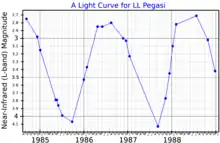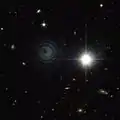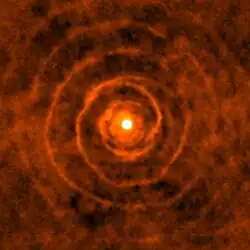| Observation data Epoch J2000.0 Equinox J2000.0 (ICRS) | |
|---|---|
| Constellation | Pegasus |
| Right ascension | 23h 19m 12.607s[2] |
| Declination | +17° 11′ 33.13″[2] |
| Characteristics | |
| Evolutionary stage | Asymptotic giant branch[3] |
| Spectral type | C[4] |
| Variable type | Mira[5] |
| Astrometry | |
| Distance | 1,300[3] pc |
| Details | |
| Radius | 1,074[6] R☉ |
| Luminosity | 10,900[6] L☉ |
| Temperature | 1,800[6] K |
| Other designations | |
| Database references | |
| SIMBAD | data |
LL Pegasi (AFGL 3068) is a Mira variable star surrounded by a pinwheel-shaped nebula, IRAS 23166+1655, thought to be a preplanetary nebula. It is a binary system that includes an extreme carbon star. The pair is hidden by the dust cloud ejected from the carbon star and is only visible in infrared light.[7]
Variability

LL Pegasi is obscured at visual wavelengths, but is strongly variable in brightness at infrared wavelengths.[8] It is classified as a Mira variable and has a period of about 696 days.[9]
Nebula
The nebula displays an unusual Archimedean spiral shape. The shape is thought to be formed through the interaction between the stellar companion and the carbon star, as has been seen in other binary systems, although not with such a precise geometric form. The distance between the spiral arms and their rate of expansion is consistent with estimates of the pair's 810 year orbital period based on their apparent angular separation.[7]
Gallery
- Observed structure surrounding the binary star system.
 Hubble Space Telescope image of IRAS 23166+1655, taken in the near-infrared. The bright object to the right is a star much closer to Earth. It was used as a guide star for adaptive optics corrections that allowed the Keck II telescope to resolve the LL Pegasi binary pair.
Hubble Space Telescope image of IRAS 23166+1655, taken in the near-infrared. The bright object to the right is a star much closer to Earth. It was used as a guide star for adaptive optics corrections that allowed the Keck II telescope to resolve the LL Pegasi binary pair.
See also
References
- ↑ "Celestial spiral with a twist". eso.org. European Southern Observatory. Retrieved 13 February 2022.
- 1 2 Cutri, Roc M.; Skrutskie, Michael F.; Van Dyk, Schuyler D.; Beichman, Charles A.; Carpenter, John M.; Chester, Thomas; Cambresy, Laurent; Evans, Tracey E.; Fowler, John W.; Gizis, John E.; Howard, Elizabeth V.; Huchra, John P.; Jarrett, Thomas H.; Kopan, Eugene L.; Kirkpatrick, J. Davy; Light, Robert M.; Marsh, Kenneth A.; McCallon, Howard L.; Schneider, Stephen E.; Stiening, Rae; Sykes, Matthew J.; Weinberg, Martin D.; Wheaton, William A.; Wheelock, Sherry L.; Zacarias, N. (2003). "VizieR Online Data Catalog: 2MASS All-Sky Catalog of Point Sources (Cutri+ 2003)". CDS/ADC Collection of Electronic Catalogues. 2246: II/246. Bibcode:2003yCat.2246....0C.
- 1 2 Lombaert, R.; De Vries, B. L.; De Koter, A.; Decin, L.; Min, M.; Smolders, K.; Mutschke, H.; Waters, L. B. F. M. (2012). "Observational evidence for composite grains in an AGB outflow. MgS in the extreme carbon star LL Pegasi". Astronomy & Astrophysics. 544: L18. arXiv:1207.1606. Bibcode:2012A&A...544L..18L. doi:10.1051/0004-6361/201219782. S2CID 119022145.
- ↑ Groenewegen, M. A. T.; De Jong, T.; Gaballe, T. R. (1994). "The 3 micrometer spectra of candidate carbon stars". Astronomy and Astrophysics. 287: 163. Bibcode:1994A&A...287..163G.
- ↑ Samus, N. N.; Durlevich, O. V.; et al. (2009). "VizieR Online Data Catalog: General Catalogue of Variable Stars (Samus+ 2007-2013)". VizieR On-line Data Catalog: B/GCVS. Originally Published in: 2009yCat....102025S. 1. Bibcode:2009yCat....102025S.
- 1 2 3 Massalkhi, S.; Agúndez, M.; Cernicharo, J. (August 2019). "Study of CS, SiO, and SiS abundances in carbon star envelopes: Assessing their role as gas-phase precursors of dust". Astronomy & Astrophysics. 628: A62. arXiv:1906.09461. Bibcode:2019A&A...628A..62M. doi:10.1051/0004-6361/201935069. ISSN 0004-6361. PMC 6739229. PMID 31511746.
- 1 2 Morris, Mark; Sahai, Raghvendra; Matthews, Keith; Cheng, Judy; Lu, Jessica; Claussen, Mark; Sánchez-Contreras, Carmen (2006). "A Binary-Induced Pinwheel Outflow from the Extreme Carbon Star, AFGL 3068". Planetary Nebulae in Our Galaxy and Beyond. 234: 469. Bibcode:2006IAUS..234..469M. doi:10.1017/S1743921306003784.
- 1 2 Le Bertre, T. (1992). "Carbon-star lightcurves in the 1-20 micron range". Astronomy and Astrophysics Supplement Series. 94: 377. Bibcode:1992A&AS...94..377L.
- ↑ Whitelock, Patricia A.; Feast, Michael W.; Marang, Freddy; Groenewegen, M. A. T. (2006). "Near-infrared photometry of carbon stars". Monthly Notices of the Royal Astronomical Society. 369 (2): 751–782. arXiv:astro-ph/0603504. Bibcode:2006MNRAS.369..751W. doi:10.1111/j.1365-2966.2006.10322.x. S2CID 14453496.
